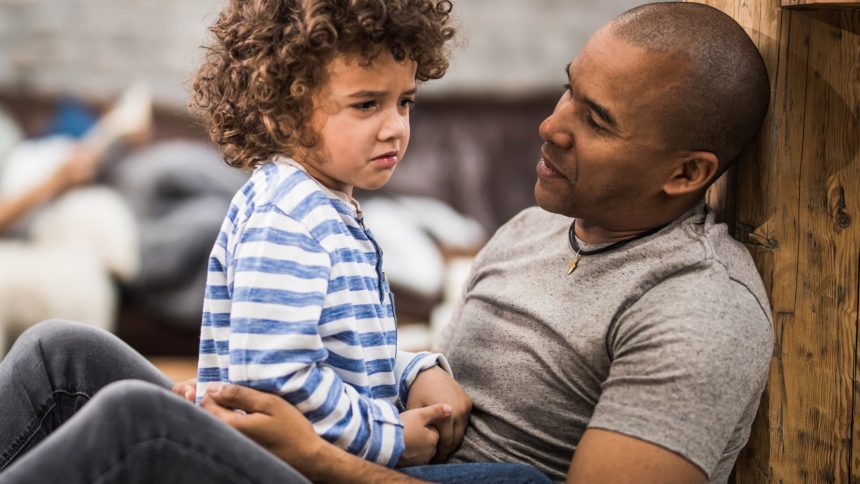One of our key jobs as parents is to teach instead of punish, even when our children are pushing back, melting down, or otherwise being “difficult.” We know it’s hard: We’ve been there plenty of times as moms ourselves. Still, we’re here to guide our children in a compassionate way through difficult moments at all stages of development.
Sometimes, when emotions are high — when we feel like a young child is being impulsive and destructive, for example, or when a teenager turns everything into a battle — we need guidance to steer us in the right direction, so that we can help our kids learn instead of shutting them down.
As child psychologists, we’ve developed an acronym that can assist us all through this process, regardless of our child’s age: H.E.L.P.
- Halt
- Empathy
- Limits
- Proximity
Here’s how to use it during difficult parenting moments:
H is for Halt
Let’s say your child is hitting their sibling with a toy or has just missed curfew. Whatever their action, before you react, it’s smart to stop and ask yourself: Where is their behavior coming from?
We truly believe that no child wants to be “bad.” Why would anyone want to fail and disappoint a person who means the world to them?
Children generally want to make us happy, and they want to succeed. But there are biological limitations working against them. An underdeveloped thinking brain, an overactive emotional brain, and a lack of perspective leads to chaos and poor decision-making. An immature brain produces immature behavior.
A child is not their behavior. Though our anxiety can interfere with our ability to see it, their behavior is a form of communication a parent is meant to decode — reflecting a need that’s unmet or a skill they’ve yet to learn.
Children often convey their struggles through “misbehavior” or meltdowns, and deal with discomfort and stress through tantrums and crying. Their “bad” behavior could mean, for example, that they’re:
- Hungry
- Tired
- Overstimulated
- Feeling unwanted, rejected, inadequate, sad, scared, lonely, angry, or ignored
- Confused about expectations
- Needing more freedom or time outdoors
- Needing a limit set
- Seeking connection
- Getting sick
- Stressed about school
- Getting too much screen time
- Not getting enough play or movement
- Not eating a balanced diet
- Struggling with a transition
It’s our job as the adults to see through the behavior to the heart of the issue.
Still, it can be hard not be reactive in the moment and resort to unhealthy scripts we may have learned through our own past experiences. We may have been taught to hide our tears to avoid shame, for example, or to lash out with anger when we felt scared to protect ourselves.
Ask yourself: Is my reaction about my emotional baggage? Meaning, “I can’t stand my child’s crying because my parents didn’t allow me to cry and it overwhelms me”? Or is my reaction a reasonable response to my child’s behavior, like if my child yelled “I hate you,” and my feelings are hurt?
Self-awareness can save us from falling into old patterns we adopted from our own family of origin and allow us to act from a place of compassion and intention.
In the case of older children, we have some critical lessons to teach and our own reactivity might get in the way. So we may take an entire day or sleep on it before moving on to E, L, and P.
E is for Empathy
This is all about ensuring our children feel safe, seen, and heard before we get into limit setting, teaching, or problem-solving. Empathy means seeing their world as they see it and believing them when they show you how they feel.
Let’s break it down:
- Welcome their feelings. Lean in, get on their level, and make eye contact.
- Acknowledge and validate their feelings. With a soft tone, say, “I can see you’re feeling so …” “You must be feeling so …” or “You’re so ____ with me right now.”
- Really listen. Summarize and/or paraphrase (e.g., “So what I’m hearing you say is your friends ignored you all day, and you felt really lonely”) and clarify if needed (“So no one talked to you at lunch and you felt really sad, am I understanding you correctly?”).
- Don’t judge. Feelings are neither good nor bad. And while behavior may not be acceptable, our children’s feelings always are.
- Don’t try to fix it. Allow for the crying, screaming, or verbal unloading. It’s about our children being seen and heard, not fixing the behavior or problem.
- Say less. Talking too much overwhelms kids. This is more about our presence.
- Regulate your own emotions. Breathe and take a moment, or several, to compose and ground yourself. Ask yourself if your reaction is about you or your child.
L is for Limits
One Thanksgiving, I had my entire extended family over for the holidays. There were at least 20 people in my home. The night before Thanksgiving, we ordered Chinese food. My son, who is normally relaxed at meals, refused to sit down or eat his food. In agitation, he threw his fork across the table and screamed, “I’m not eating this!”
My goal in the moment was to draw boundaries, create structure, and teach more appropriate behavior. I used simple statements that employ as few words as possible as I worked to:
- Validate my child’s emotion
- Convey that his behavior was not acceptable
- Offer alternatives
It came out something like this: “I can see you’re so frustrated right now, you don’t want to eat your dinner. But you may not throw things when you’re upset. You may tell us that you’re frustrated or take a quick walk and come back.”
In the case of my son at Thanksgiving, he exploded into tears when I set a limit. But that didn’t mean the limit was wrong. I realized he needed quiet and connection from me first — in other words, empathy and proximity.
P is for Proximity
Often our children negotiate, plead, or bargain with us to get us to change the limits. When they realize our answer is still the same (e.g., “honey, I still have a ‘no’ in me”), they get upset.
You might be tempted to walk away because you’re overwhelmed by their response or feel like you’re being permissive indulging their drama. But this emotional processing is completely healthy and normal. For our children to become successful at self-regulating, we first have to co-regulate them.
To help calm our children, we need to stay close. Look for the moment when their anger or frustration shifts into sadness. This is the golden moment of connection we don’t want to miss. It’s the key to children learning they can be vulnerable and show their authentic self.
Whether we’re parked on the floor, sitting at the kitchen table, or cuddled up on the couch, we should never underestimate the power our physical presence holds.
Tammy Schamuhn is a Registered Psychologist and Registered Play Therapist Supervisor, and the cofounder and director of the Institute of Child Psychology. She’s worked in private practice for over a decade, primarily with children and their families, and supervises master’s-level students. She is the coauthor of “The Parenting Handbook: Your Guide to Raising Resilient Children.”
Tania Johnson is a Registered Psychologist, Registered Play Therapist, and cofounder and director of the Institute of Child Psychology. In her private practice, Tania specializes in parent consults, and works primarily from the perspective of attachment theory. She is the coauthor of “The Parenting Handbook: Your Guide to Raising Resilient Children.”
Want to make extra money outside of your day job? Sign up for CNBC’s new online course How to Earn Passive Income Online to learn about common passive income streams, tips to get started and real-life success stories. Register today and save 50% with discount code EARLYBIRD.
Plus, sign up for CNBC Make It’s newsletter to get tips and tricks for success at work, with money and in life.
Read the full article here




